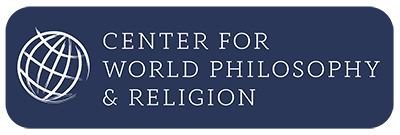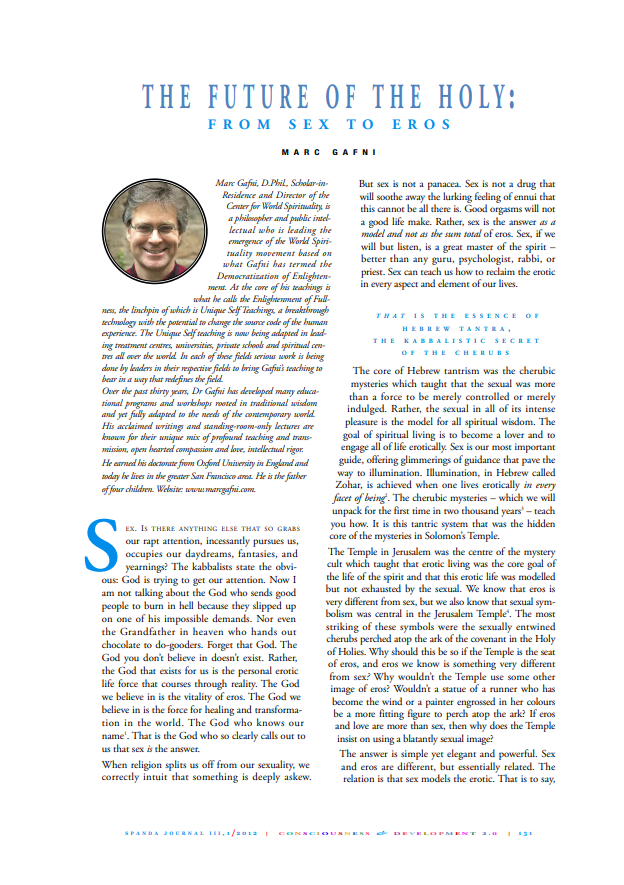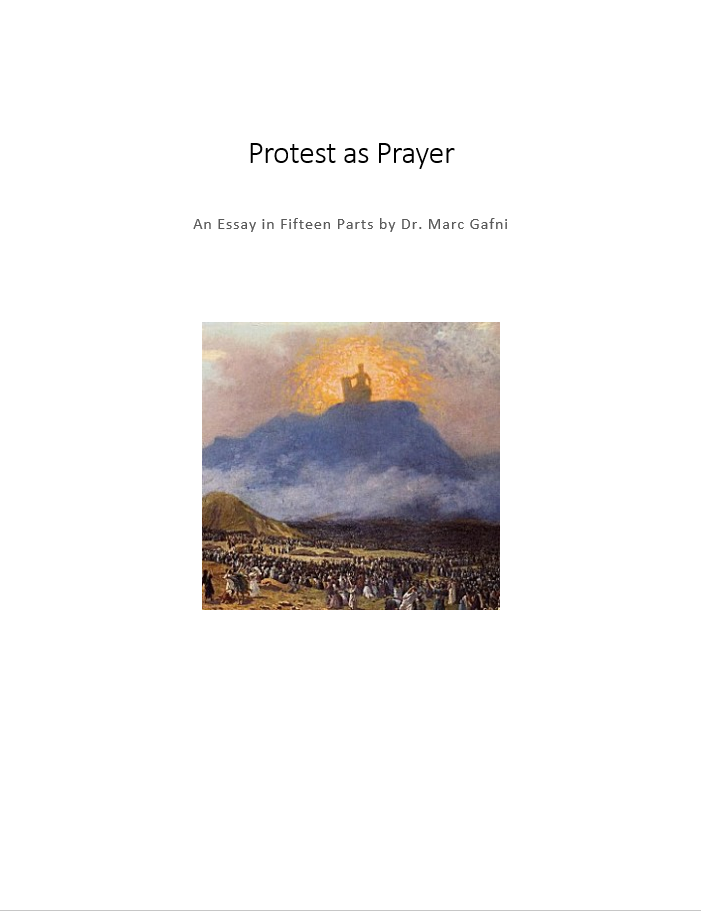Enlightenment of Fullness — Yetzir and Yetzirah, Part I
Looking for more on the wisdom tradition that aligns you with your deepest creativity? In a three-part excerpt from the long version of Soul Prints, Marc Gafni writes that we can transform and raise our passion and artistic creativity into a powerful drive for the sensual and the holy, realizing that, in a redeemed world, they are one and the same. As long as our spirituality remains vapid and empty, we indeed need to repress the more primal, creative passion, lest it overwhelm us. Primal passion unrealized is soul print or Unique Self destiny unrealized.
You can view Part II of this essay in full by clicking here>>
You can view Part III of this essay in full by clicking here>>
Yetzer and Yetzirah: Raising the Primal Sparks of Creativity and Passion
by Dr. Marc Gafni
from “The Way of the Dragon“ in the long Soul Prints.
Part I.
In biblical spirituality, information about God is relevant for one reason only. Information about God is information about us. We are commanded to be little Gods – to imitate God. Just as God stood at the abyss of darkness and said let there be light, so are we commanded to stand at the abyss of our darkness and say let there be light. A little bit of light dispels so much of the darkness. Further, just as God is a creator – creating, sculpting, painting, composing a gorgeous physical world – so, too, are we invited to create, to sculpt, to paint, and to make music.
Mozart, Bach, Schubert, Rembrandt, and Michelangelo created. And yet, creativity is still viewed as suspect by much of the religious community. Art per se and artists to be sure are suspected of being amoral at best and, more probably, immoral. Acting, painting, sculpture, song are held in both high esteem and moral disdain. Why? The answer, which we have already introduced in our earlier discussion, emerges from an understanding of the deep linguistic and conceptual relationship between the biblical myth terms Yetzer and Yetzirah. Yetzirah means creativity; Yetzer is best translated as primal instincts, including but not limited to libido (Freud), the drive for power (Adler, Nietzsche), and the need for meaning (Frankel). In the Hebrew language, which is the ultimate source of all biblical myth thought, Yetzer and Yetzirah are the same word, linked etymologically and conceptually. The point: I cannot create without connecting deeply to my most primal instincts.
In my earlier twenties, I attended for a short time a prestigious drama workshop in Greenwich Village in New York. When we would be preparing for a murder scene in a play, we would do exercises to help us access the murderous rage lurking untapped in the corners of our souls. I cannot create drama about murder without unlocking the murderer in myself. To create anything – and certainly for the ultimate creation, the creation of myself – I need to be able to access the most primal passions of my being. Herein lies the attraction and the danger. My primal instincts when not integrated into my fully developed self are often not channeled properly and can potentially destroy worlds. Witness Germany. My mother, who was there, told me almost every day as I was growing up that the same people who gassed Jews in the morning, listened, with great primal passion, to Mozart in the evening.
In response to this psychological reality, Biblical myth spirituality taught: “Who is heroic, he who is (Kovesh) conquers his Yetzer.” And if the price is also to sacrifice certain forms of creativity, so be it. Better to be moral, holy, and not creative, than creative and immoral.
And yet having to choose between the primal passion of creativity and morality is far from satisfying!!
Visit centerforintegralwisdom.org for more wisdom teachings from Dr. Marc’s writings and the other teachers of the Center for World Spirituality.
A CWS Board Statement of Unequivocal Support for Dr. Marc Gafni
A Statement of Unequivocal Support, from a Special Committee of the Board of Directors for the Center for World Spirituality, in Response to Attacks directed against Marc Gafni, D.Phil. in the Blogosphere During September 2011:
We, the undersigned, do without any reservation whatsoever, support Marc Gafni, D.Phil as a teacher and leader of the Center for World Spirituality. We find it unfortunate that the blogosphere has become a place where allegations are made, and where rumors, distortions and simple untruths are so easily spread, all without the benefit of finding of fact.
We have done due diligence on this matter. Members of our group have deeply heard the perspectives of everyone referred to in the spate of blogosphere attacks in Sept 2011. Between us, we have gathered what we believe to be all the relevant evidence possible under these fragmented circumstances. As one of our teachers said about these events, there is “So much flame, so little fact,” and much confusion between “facts and interpretations of facts.” We have gathered all the relevant subjective and objective information possible under these circumstances. So it is with genuine confidence we give our full support for Marc Gafni. We trust Marc’s leadership and remain solidly convinced of his integrity, especially as he faces the challenges of leading a change movement in a world characterized by fear. Further, each of us personally recommends Dr. Gafni to any organization, church, synagogue, spiritual or cultural center, or to any context which seeks to benefit from his teachings.
The Center for World Spirituality remains fully committed to its consciously creative mission under the joint stewardship of Dr. Gafni and the circle of board members, colleagues and students who have stepped up to lead. We know Marc to be an inspired teacher, a visionary leader, a human being engaged in life with an open heart and a passionate creativity. That passion, along with a remarkable intellect, and a deep formation in one of the world’s great spiritual traditions, moves him to a profound understanding of the human condition and the movements of Spirit unfolding within and around us.
We look forward to the years ahead as Marc’s creative insights into the Unique Self, World Spirituality, and the Enlightenment of Fullness, unfold into a corpus of written works, and as they come to greater expression through the world wide gatherings which make up the Center for World Spirituality.
Signatories:
Chahat Corten, Wyatt Woodsmall, Ph.D., Marty Cooper, Warren Farrell, Ph.D.*, Lori Galperin, Mike Ginn, Tom Goddard Ph.D., Leon Gras, Sally Kempton, Heather Ussery-Knight, Victoria Myer, Dr. Gabriel Cousens, MD, PhD, Kathleen J. Brownback, M.Div., MBA, Wyatt Woodsmall, Ph. D.
*Dr. Warren Farrell also added his own personal statement in this regard:
To Whom It May Concern,
This is to express my unequivocal support for Marc Gafni, D.Phil. as a teacher and visionary leader of the Center for World Spirituality. In my work with him as a friend, co-facilitator of content, and Board member of the Center, I find him to be one of the world’s truly extraordinary men. He blends integrity with skills of leadership, vision, creativity, and charisma. He harbors a renaissance intellect and comprehension of history, religion and spirituality–and harnesses that into the hearts and souls of those whose hearts are open and whose souls are wise enough to be deepened.
Marc Gafni is one of the world’s change agents. Virtually all change agents, whether Martin Luther King or Gandhi, will be subjected to attempts at assassination–character assassination and sometimes literal assassination. Unfortunately, the internet has allowed such attempts to be magnified when aimed at a leader’s character. This propensity of people without vision to try to ruin the person rather than challenge the ideas has long been with us. As Mark Twain put it, “A lie can travel halfway around the world while the truth is putting on its shoes.” With the internet, a lie can travel all the way around the world while the truth is finding its shoe.” In the process, it is easy to lose the message of a visionary leader.
Marc continues to make a commitment to lead; I for one, am making a commitment both to continue co-creating with him and to never allowing myself to be sidetracked by those whose feel it is easier to kill the messenger than create a more visionary and informed message.
Warren Farrell, Ph.D.
Common Ground: Sex & Spirit: Wisdom of the Spiritually Incorrect
 By Marc Gafni
By Marc Gafni
Note: The following article appeared in the December 2012/January 2013 issue of Common Ground Magazine.
If you stop to think even for a short moment, you realize that sex really is the great mystery of our lives. Two groups, however, suggest very different approaches to sex, and both of them are wrong.
One powerful group of forces is arrayed in culture to prevent us from getting sex. They tell us that sex is somehow wrong, immoral, or sinful. Even when we think we have gotten free of them, they pop up again inside our hearts or heads, wagging their fingers disapprovingly. And they remind us constantly of all the trouble sex has gotten the world into ”” from the Trojan War to the Clinton/Lewinsky drama. Not to mention the trouble it has gotten you and me into””emotionally, psychologically, personally, professionally, and physically. You have to admit that the sexual conservatives have a point. If you want to keep life simple, clean, and orderly, forgoing or limiting your sexual experience might be an excellent choice. If you like spiritual exercises, take a few minutes to list all the times sex has gotten you into trouble.
Lots of conventional moralists and organized religion fall into this category. Religion wants to affirm love and passion as virtues but to divorce them entirely from sex. So moralist religion works hard to erect boundaries that will protect us from the pitfalls of sex. Yet while we all know that sex requires some discipline, and that context and commitment count, most of us know in our hearts that the moralists are wrong, and that sex is ultimately””and overwhelmingly””good, and not merely a side benefit of achieving loving relationship.
To read the entire article, download it as a PDF file.
Our Unique and our Authentic Self (Tom Steininger and Sonja Student in Dialogue; Translated by Kerstin Tuschik)
The page you are trying to reach is part of our Great Library Stacks & Archives. If you already signed up for our FREE Great Library card, please log in to access this content.
If you are not yet a Library Card owner, you can sign up to get access.
Common Ground: Your Unique Self: What It Means to Be a Lover … from God’s Eyes

Note: The following article appeared in the December 2012/January 2013 issue of Common Ground Magazine.
The true nature of your values is always revealed in death. In eulogies, both in what is spoken and unspoken, there is something of the essential nature of your life and loyalties. Sometimes, however, before you die you are strangely privileged to declare where your ultimate loyalty lies.
It was September 11, 2001. The planes had just crashed into the Twin Towers in Manhattan. Victims had moments to use their cellphones. No one called asking for revenge. No one offered philosophical explanations or profound insights into the nature of reality. People did one thing and one thing only: they called the people close to their hearts to say, “I love you.”
“I love you” is our declaration of faith. Implicit in those words is everything holy. Yet we no longer know what we mean when we say it.
It used to mean, “I am committed to you. I will live with you forever.” Or it might have meant, “You are the most important person in my life.”
But it no longer seems to mean that. And when you no longer understand your own deepest declarations of love, you are lost. You become alienated from love, which is your home. Despair, addiction, and numbness become your constant companions.
To read the entire article, download it as a PDF file.
Dr. Marc Gafni: Paper on Three Steps to the Democratization of Enlightenment
The page you are trying to reach is part of our Great Library Stacks & Archives. If you already signed up for our FREE Great Library card, please log in to access this content.
If you are not yet a Library Card owner, you can sign up to get access.
Marc Gafni on Post-Postmodern Art: A New Article in Parabola Magazine
 By Marc Gafni
By Marc Gafni
Artist Claudia Kleefeld is not the first person to see the symbol of the spiral as being a portal to a vision of a coherent cosmos. She is original in that she is a first-rate, old-master-style artist with thirty years of training, who paints the spiral as an expression of an Eros of certainty that asserts the utter meaningfulness, depth, and order of the cosmos. Kleefeld’s paintings emerge from her own opened eye of the spirit and speak directly to the higher spiritual intuition of her viewers. Finally, Kleefeld is unusual in that she is part of an emergent form of art, which seeks to reveal the enchantment of a cosmos ”” a cosmos that is good, true, and beautiful.
I am delighted to present an article which celebrates the work of Claudia Kleefeld, one of the brightest shining lights in the universe of art today. My new article, “Post-postmodern Art: A Return to Belonging,” is now published in the latest issue of Parabola Magazine.
Marc Gafni’s “The Future of the Holy: From Sex to Eros” Appearing in Spanda Journal
 Marc Gafni was recently featured in Spanda Journal, the peer-reviewed biannual publication of the Spanda Foundation.
Marc Gafni was recently featured in Spanda Journal, the peer-reviewed biannual publication of the Spanda Foundation.
The Spanda Foundation offers publications related to “sustainable advancement of peace, knowledge, and understanding.”
Marc’s article, entitled “The Future of the Holy: From Sex to Eros,” begins like this:
“Sex. Is there anything else that so grabs our rapt attention, inessantly pursues us, occupies our daydreams, fantasies, and yearnings? The kabbalists state the obvious: God is trying to get our attention. Now I am not talking about the God who sends good people to burn in hell because they slipped up on one of his impossible demands. nor even the Grandfather in heaven who hands out chocolate to do-gooders. Forget that God. The God you don’t believe in doesn’t exist. Rather, the God that exists for us is the personal erotic life force that courses through reality. The God we believe in is the vitality of eros. The God we believe in is the force for healing and transformation in the world. The God who knows our name. That is the God who so clearly calls out to us that sex is the answer.”
For the entire article, click: SPANDAJOURNAL_C&D2.0_Marc_Gafni.
See: Gafni, M. (2012). “The Future of the Holy: from Sex to Eros”, Spanda Journal, ed. S. Momo, III,1: 131-139.
Dr. Marc Gafni: Foundations for World Spirituality: Learning the Language of God (Part 1 of 5)
Editor’s note: This is the first part of 5-part essay, published as a white paper of the Center for Integral Wisdom think tank. For Part 2, Part 3, Part 4, and Part 5, follow the links.
 “As the Kabbalists point out, the word Moses spelled backwards is Ha Shem, meaning ‘the name.’ Importantly, Ha-shem in biblical Hebrew also is the most common reference to God’s name. When you respond to your call and realize your soul print, fully becoming your name, you become one with God. When Moses did this, he found his voice, he became a prophet.”
“As the Kabbalists point out, the word Moses spelled backwards is Ha Shem, meaning ‘the name.’ Importantly, Ha-shem in biblical Hebrew also is the most common reference to God’s name. When you respond to your call and realize your soul print, fully becoming your name, you become one with God. When Moses did this, he found his voice, he became a prophet.”
By Marc Gafni
To live your story is to move from a state of slavery to freedom. Slavery is not limited to our old image of the oppressed Hebrew or black slave being whipped by the cruel master. We are all potentially free, just as we are all potentially slaves. Our intent in this brief essay is to at least begin to unpack a core intuition of the Zohar that a free person is a person who has found voice. As we shall see in the very last paragraphs of this discussion the implications of freedom are wondrous indeed!
The Hebrew name for the Passover Storytelling Ritual, which celebrates and reenacts the dynamic movement from slavery to freedom, is Pe-Sach. Renaissance mystic Isaac Luria reminded us that Pe-Sach is a combination of two words Peh, meaning “mouth,” and Sach, meaning “talk.” Pe- Sach, therefore, means the mouth that talks.
One school of Hasidic masters unpacks this idea by defining redemption as the emergence of speech. To move from a dumb and mute existence to a communal storytelling existence is to undergo redemptive transformation. “To be redeemed,” writes one mystic, “is to lead a history-making, storytelling, communing, free existence.” To be in exile is to lack history, tell no story, fail to commune, and exist as a slave, silent.
The most oft cited source for this idea is a stunning passage in the Zohar which describes the Egyptian slavery as the “exile of speech.” In Kabbalah, every biblical nation represents a different organ of the body; Egypt represents the throat. The mystics read the Hebrew word “Egypt” literally as meaning narrowness. The throat is, of course, the narrow, constricted passage between the wide spaces of the heart and mind. The narrow throat, Egypt, is thus the ideal symbol for the exile of speech. Speech remains caught in the throat, in the dark passage, and can’t make it to freedom’s gateway, the mouth. Redemption comes in the birth of the word. In the actual process of your retelling, you reclaim your story. But to be capable of retelling your story you need voice. Redemption then is the process of finding voice.
The Greatest Persecution
In the Nazi concentration camps, certain people were referred to as mules. They were so broken that, although not physically impaired, they could no longer speak. Among animals, mules are the hybrid of a horse and donkey, unable to reproduce themselves. These human, muted mules were so traumatized, their souls so mangled, that they too were unable to “reproduce themselves”–to express themselves in speech.
The great master Kalonymous Kalman of Piacezna wrote from the flames of the Warsaw ghetto that the torture of the exile is not only in the physical suffering but in the inability to cry out – the loss of voice. “The people have become mute,” he cried out in a teaching given in 1940, just weeks after his son and daughter in law and many of his disciples were brutally killed. The teaching was on the story of Joseph and his brothers in the book of Genesis. In a dream, Joseph sees “the binding of sheaves in the midst of the field. And behold my [Joseph’s] sheave, rose up.” In the simple reading of the text, this is a dream of Joseph’s future power. The bound sheaves represent the servility of his brothers while the rising of his sheave is an expression of his potency. Joseph is predicting he will be lord over his brothers. Kalonimus Kalman uses the classical interpretive method of the mystic–reading the text independent of its context (here, Joseph and his brothers) and focusing on subtle wordplays and dual meanings–to extract a deeper spiritual meaning. For Kalman, the sheaves represent his disciples. The word for sheave in Hebrew also means “mute”: “My disciples are mute in the field of the spirit.” They have lost voice. Their suffering is so intense that it defies and destroys all expression. “However,” continues the master, “my sheave–that is, my muteness–must rise.” By this he means, “I must find voice.”
Kalman sees the role of the mystic leader, himself, as retaining voice, holding on at all costs to the ability to talk. He does not mean speech in the technical sense, of which even the slave is usually capable. He refers rather to the ability to have the voice that allows you to remain the storyteller of your own tale””even in the face of Nazi horror.
Kalonymous Kalman took on this role by continuing to teach even when he couldn’t be certain anyone survived to hear him. He risked all to record his teachings and hide them in the hope they would be found by some future generation. He was continuing to tell the story. In an act of heroic protest, he refused to allow the Nazis to claim “his-story.”
Kalman’s book, along with his voice, was lost in the war. He died in the Treblinka concentration camp and his book disappeared. Although he left word that he had buried his writings before being deported, they were not to be found. That is, until almost fifteen years after the Nazi defeat when a Polish worker miraculously discovered them in a pile of rubble and somehow understood their importance. The work has since been published. Treblinka may have succeeded in killing the Master of Piacezna, but it could not kill his voice. He died but his words did not. His voice triumphed.
Voices can indeed triumph even when the storyteller dies. For a version of Kalman’s story that is completely different yet exactly the same, we turn to Alice Walker’s classic work, The Color Purple. The novel focuses on two sisters, abandoned by their father to the custody of a man referred to as Mistah. One sister gets away. The other remains behind. What keeps the captive sister from losing her soul? The letters she sends to her sister. By telling her story she avoids be sucked into the slavery’s dark and deadly vortex.
In Blaise Pascal’s words, silence is “the greatest persecution.” Silence can forge the bonds of slavery even if you have not been sold by Dad to a man named Mistah or suffered the brutality of Nazism. Whenever you give up the belief that you are special and deserve to have a voice, you become a slave. Whenever you work in a place that instills fear, whenever you are afraid to speak up and ask for what is your due, you are a slave.
This post is the first in a five-part series of posts, “Foundations for World Spirituality: Learning the Language of God.” For Part 2, Part 3, Part 4, and Part 5, follow the links.
Love in Action: Unique Self – Unique Projects
The page you are trying to reach is part of our Great Library Stacks & Archives. If you already signed up for our FREE Great Library card, please log in to access this content.
If you are not yet a Library Card owner, you can sign up to get access.
Marc Gafni’s Visit to Exeter Report by Kathy Brownback
The page you are trying to reach is part of our Great Library Stacks & Archives. If you already signed up for our FREE Great Library card, please log in to access this content.
If you are not yet a Library Card owner, you can sign up to get access.
Dr. Marc Gafni: Interiors, Face, and the Reconstruction of Eros
By Dr. Marc Gafni
Summary: The four faces of eros, described by Marc Gafni in this excerpt from Mystery of Love (2003), are 1.) being on the inside, 2.) fullness of presence, 3.) desire, and 4.) interconnectivity of being. As Marc describes, with its mystical role in these four expressions, the face itself is the truest reflection of the erotic. In the flow of eros, we access the experience of being on the inside of God’s face, which Marc explores here through the Temple mystery of the sexually entwined cherubs atop the Ark who are positioned face to face; the Hebrew word “panim,” which means “inside, face, and before;” and the erotic experience of having a true face-to-face conversation. This significant passage from Mystery of Love invites you to embody the erotic which is modeled but not exhausted by the sexual more deeply in your own life.
Eros has many expressions. Each expression is hinted at in the temple mysteries. There are four faces of eros which, when taken together, form the essence of the Shechina experience. In this essay, we will explore the erotic understanding which forms the matrix of the secret of the cherubs and informs every arena of our existence. As we shall see, at the very heart of Hebrew tantra was a very precise and provocative understanding of the relationship between love, sex, and eros. This will open us up to a whole new understanding of our sexuality and will show us the way to erotically reweave the very fabric of our lives in more vivid patterns, sensual textures, and brilliant hues.
The First Face of Eros: On the Inside
“What lies behind us and what lies before us are tiny matters compared to what lies within us.” – Ralph Waldo Emerson
The cherubs in the magical mystery of Temple myth were not stationary fixtures. No, these statues were expressive, emotive. They moved. When integrity and goodness ruled the land, the cherubs were face to face. In these times, the focal point of Shechina energy rested erotically, ecstatically, between the cherubs. When discord and evil held sway in the kingdom, the cherubs turned from each other, appearing back to back instead of face to face.1 Back to back, the world was amiss, alienated, ruptured. Face to face, the world was harmonized, hopeful, embraced. Thus, face to face in biblical myth2 is the most highly desirable state. It is the gem stone state of being, the jeweled summit of all creation. Face to face, to be fully explicit, is a state of eros.
Every Detour is the Destination (By Tom Goddard and Marc Gafni)
The page you are trying to reach is part of our Great Library Stacks & Archives. If you already signed up for our FREE Great Library card, please log in to access this content.
If you are not yet a Library Card owner, you can sign up to get access.
Dr. Marc Gafni: Protest as Prayer (Part 1): A Response to Tragedy the World Over
God = The Infinity of Intimacy: From the Infinity of Power to the Infinity of Intimacy
Part 1:
By Marc Gafni
The mandate of biblical consciousness demands that the human being enter into partnership with God in the task of perfecting the world. The classical expression of this in the lineage of Kabbalah is the obligation of Tikkun. Tikkun means not merely to hear or to fix but to be co-creative evolutionary partners with the divine.
This evolutionary mandate to co-create and to heal the world with and as divinity emerges, paradoxically, not out of answers but out of questions. The fact that the human being can challenge and that God accepts the human challenge implies a covenantal partnership between the human being and God. Both the human being and God share an understanding of the good, and thus God can turn to the human being and say: “I invite you, nay, I demand that you be my partner, my co-creator in the perfection of the world. I began the process of creation; I established the moral fabric of the world. It is up to you to take that cloth and to weave it fully. It is up to you to complete the tapestry, it is up to you to risk to grow and to create a world in which good, love, justice and human dignity flourish and are affirmed.’ A human being who cannot be trusted enough to challenge evil can also not be a partner in fostering the good.
It is true that God very often seems silent in response to our challenge. Yet Jewish consciousness, expressed through biblical text and tradition, affirms that God accepts the validity of the question. In doing so God affirms our role as God’s partner in history. If I am able to recognize evil for what it is, then I am ipso facto obligated in tikkun olam – the obligation to act for and with God in the healing of the world. Man is the language of God. We are God’s adjectives, God’s adverbs, God’s nouns and sometimes even God’s dangling modifiers. We are God’s vocabulary in the world. When I love, when I am able to be truly vulnerable and intimate with another human being, when I am able to share the pain of another and to rejoice in their deep joy, I am acting for God. I become God’s chariot in the world.
More than this: if I can wrestle with God, if I can express my uncertainty with God in the intimacy of challenging relationship, then paradoxically, I convert my doubt into the core certainty of divine relationship.
Note: This post is part of a 15-part paper.
Read More Parts Here:
Dr. Marc Gafni: The Seven Levels of Certainty and Uncertainty
 By Marc Gafni
By Marc Gafni
The following are notes from Marc Gafni’s dharma talk given in March 2012 at Shalom Mountain Wisdom School, where Gafni serves as the World Spirituality Teacher in Residence.
Introduction
The seven levels of certainty and uncertainty tells the story of how the great religious traditions came into being and how they were challenged first by science, and then by modern and post-modern mindsets.
This is a rough sketch of a map of certainty and uncertainty.
We have forgotten what we know. Indeed we do not know whether we know or not at all. We do not know whether we know or what we know or even how to know. The general impression today is that anyone who claims to know something is lost in dogma or regressive fundamentalism. Indeed almost the definition of a fundamentalist is someone who claims to know something with is totally “true” about Ultimate issues.
A person cannot survive and certainly cannot thrive without knowing.
A generation cannot survive without its knowing. A generation certainly cannot participate in the evolution of consciousness, which is the evolution of love, without knowing what it knows.
The public teachings of the great traditions were not about enlightenment. Enlightenment teachings in virtually all of the great traditions were esoteric. The great traditions taught the masses of people by leading them to believe a set of dogmas. Whether it was Christians professing, “Jesus is a saving grace,” Tibetan Buddhists or Jews professing, “We are the chosen people,” or Hindu doctrine, there was always a set of dogmas.
In each of the great traditions, a belief in a set of dogmas leads to a set of actions. The great traditions motivated people by infusing their daily lives with the belief that these actions were ultimately right. What motivated the actions was the belief that the actions were in alignment with the core constructs of the cosmos. Failing to do these aligned actions was sin, punishable not only in this world but in the next. Some of the dogma reflected deep reflection on the nature of the cosmos. Other doctrines emerge from the surface structures of that particular religion’s journey in history.
The goal was almost always a complex mixture of ethics and a sense that these teachings led the most possible people to lead lives that were most right in accordance with an ultimate knowing of the nature of reality.
Almost every system has a strong sense that is was the best system of human living. Other systems were thought to be inferior is some substantive way.
In all the great religions, to be in alignment with the beliefs and actions of “my system” meant public membership, the obligation to perpetuate my system, to be in alignment with the Gods, to be obedient to the Gods, to be responsive to the Gods.
So the story begins with each of the religions holding absolute certainty in regard to right action, right belief and the essential structure of the cosmos.
Post-modern naturally moves to reject these certainties for any number of compelling reasons. One of the most powerful is that virtually every religion claims to have an exclusive truth that competes with and contradicts the exclusive truth of another religion. So it seems that since not everyone can be right, everyone is probably all wrong. And we are left – after all the great postmodern deconstructions of knowing — with a painful and gaping uncertainty. The only certainty of post-modernity seems to be that you cannot be certain of anything. And any sort of claim to true knowing or certainty of any kind is in many circles mocked or worse. It is thought to be dangerous — as we said earlier — a sure sign of fundamentalist thinking.
But the true relation of certainty and uncertainty, knowing and unknowing, is far more nuanced and interesting. And to understand it is essential. We absolutely move beyond the post-modern dogmatic certainty which deconstructs all knowing and bows only to the ultimate and all pervasive claim of radical uncertainty. So let’s reconstruct some of the stages in spiral dance between certainty and uncertainty and let this be the beginning of our post-postmodern reconstructive project in which we are able to reclaim the Eros of knowing even as we hold the Eros of not knowing.
We begin with a simple reconstruction of seven levels of certainty and uncertainty.
Teaching Marc Gafni’s “Unique Self” Enlightenment in the classroom – by Kathy Brownback
By Kathleen Brownback
Note: This blog post is adapted from “Teaching Marc Gafni’s ‘Unique Self’ Enlightenment in the Classroom: Reflections from a Phillips Exeter Class in Mysticism (for the annual conference of the Association for Contemplative Mind in Higher Education, November 2011, Amherst College).”
A new course introduced at Phillips Exeter Academy in the spring of 2011 began with these words on the syllabus:
What we are about to explore has many names. It has been called the mystical tradition, the perennial tradition, the direct path, the path of the heart, the journey to (and with) the beloved, the practice of yoga, and the contemplative tradition. Aldous Huxley called it “the science, not of the personal ego, but of that eternal Self in the depth of particular, individualized selves, and identical with, or at least akin to, the divine Ground.” What these traditions share is the understanding that there is the possibility of union between the self and whatever we might call Ultimate Reality or God or Spirit, and that this union is primarily realized through a path of spiritual practice.
There is no possible way to make a comprehensive study of all these traditions in one term, and no need for us to do so. The main goal here is to locate various paths within the religious traditions, and to begin to understand what is meant by “spiritual practice.”
As the first teacher of this class, my main goal was to engage the students in a deeper understanding of ego development and the way in which the contemplative or mystical dimension of religion could help them both intellectually and practically as they move into their adult lives.
Phillips Exeter is a secular independent secondary school in New Hampshire, an hour north of Boston, with a 200-year history as an academic powerhouse for boys. It became coeducational in 1972 and has retained its high academic distinction, with all students headed for college and many to the top schools in the country.
The students are bright and lively and curious. But as anywhere, they struggle at times with nonacademic life circumstances that have the capacity to affect their intellectual engagement””a superficial and highly commercialized teenage (and often adult) culture, a pervasive unease about the future of their society in an era of environmental and economic challenge, and for some, personal or family histories of addiction or depression. For this reason I sought out texts and readings that were inclined to prompt questions at the interface of psychology and religion. I had the sense that these would speak to students in both an academic and a personal way, as in fact they did.
In this paper I will first describe student background and interest, then give a brief overview of the course, then focus on the work of one scholar and teacher, Marc Gafni, whose writing in particular spoke to the students in a powerful way.
In the course of the term I had to develop and articulate to myself my own changing philosophy of teaching, which I began to explore in a 2009 article in the Exeter alumni/ae bulletin entitled “In Pursuit of Truths.”
I will describe this evolution more deeply at the end of the article, but also briefly mention it here.
Thoughts on The Unique Self
The page you are trying to reach is part of our Great Library Stacks & Archives. If you already signed up for our FREE Great Library card, please log in to access this content.
If you are not yet a Library Card owner, you can sign up to get access.
Your Unique Self: The Future of Enlightenment with Marc Gafni
The page you are trying to reach is part of our Great Library Stacks & Archives. If you already signed up for our FREE Great Library card, please log in to access this content.
If you are not yet a Library Card owner, you can sign up to get access.
Leadership
There are different groups of individuals who provide leadership or vision for the organization in different capacities.
Each organization [Center for World Philosophy & Religion, Office for the Future, and Foundation for Conscious Evolution] has a distinct legal board, which makes its decisions. All the decisions are made collectively by the appropriate board and board leadership. The listing below includes present and former board members, research fellows, faculty, and officers of the organization.
We have intentionally not broken them out by designation, as all of these people contribute equally needed value to the overall missions of these distinct organizations.
We are in the process of changing the name of The Center for Integral Wisdom to Center for World Philosophy & Religion.
The Center for Integral Wisdom is a 501C3.



